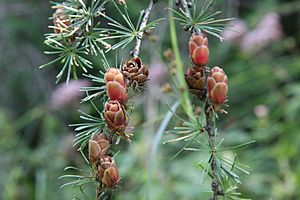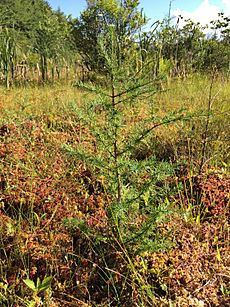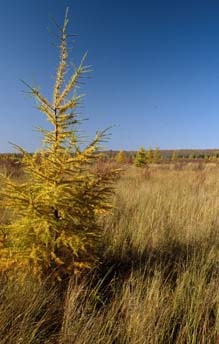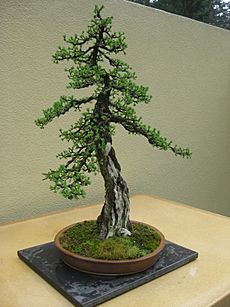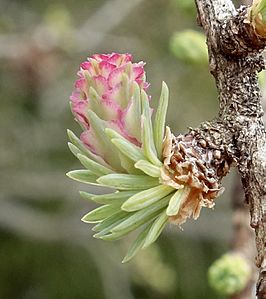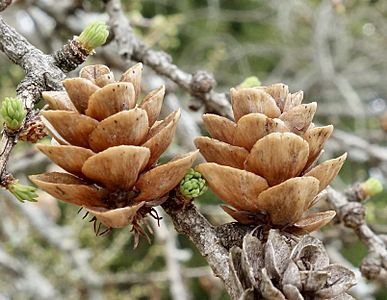Tamarack facts for kids
Quick facts for kids Tamarack |
|
|---|---|
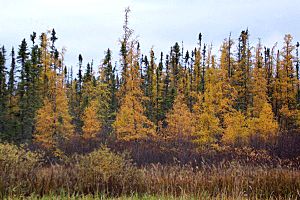 |
|
| Tamarack larch in fall colors, with black spruce in the background | |
| Conservation status | |
| Scientific classification | |
| Genus: |
Larix
|
| Species: |
laricina
|
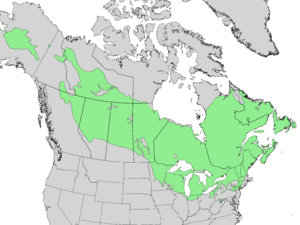 |
|
| Natural range of Larix laricina | |
| Synonyms | |
|
|
The Larix laricina, often called the tamarack tree, is a type of larch. People also know it as hackmatack, eastern larch, black larch, red larch, or American larch. This tree grows naturally across Canada, from the eastern Yukon to Newfoundland. It also grows in the northeastern United States, from Minnesota to West Virginia. You can even find a small group of them in central Alaska. The name akemantak comes from an Algonquian word. It means "wood used for snowshoes."
Contents
What Does the Tamarack Tree Look Like?
The tamarack is a small to medium-sized tree. It can grow from 10 to 20 meters (about 33 to 66 feet) tall. Its trunk can be up to 60 centimeters (about 2 feet) wide. Tamaracks are special because they are conifers (trees with cones) that are also deciduous. This means they lose their leaves every autumn, just like oak or maple trees.
The bark of the tamarack is tight and flaky. It looks pink, but if you peel off the flakes, it can appear reddish underneath. The leaves are like needles, about 2 to 3 centimeters (1 inch) long. They are a light blue-green color. In the fall, these needles turn a bright yellow before they drop off. This leaves the branches bare until spring.
Needles and Cones
Tamarack needles grow in two ways. Some grow in a spiral pattern on long shoots. Others grow in tight groups on short, woody spurs. The cones of the tamarack are very small. They are only 1 to 2.3 centimeters (about half an inch) long. Each cone has 12 to 25 scales. When they first appear, the cones are bright red. They turn brown and open up to release their seeds about 4 to 6 months after pollination.
Here are some key things to remember about tamarack trees:
- Their needles usually grow in groups of 10 to 20 on short shoots.
- Tamaracks are deciduous, so their needles turn yellow in autumn.
- The seed cones are small, less than 2 centimeters (0.8 inches) long. They have shiny brown scales.
- You often find tamarack trees in wet areas like swamps, fens, and bogs.
Where Do Tamarack Trees Grow?
Tamarack trees can handle very cold weather. They can survive temperatures as low as -65 degrees Celsius (-85 degrees Fahrenheit). This is why they often grow at the edge of the Arctic tundra, where the tree line ends. Trees in these very cold places are usually smaller, sometimes only 5 meters (16 feet) tall.
Tamaracks can grow in many different types of soil. But they are most common in wet, organic soils. These include sphagnum moss, peat, and woody peat found in swamps and bogs. They can also grow in mineral soils, from heavy clay to coarse sand. Even though they can grow in soils with lime, you won't find many in the limestone areas of eastern Ontario.
Tamarack trees are often the first trees to grow in bogs that used to be lakes. In some areas, they might appear in the moss or bog shrub stage. Farther north, they are the first trees to grow after shrubs in bogs. Tamaracks are also good at growing back after a fire. This makes them a common "pioneer species" in forests after a fire.
Some scientists think the tamarack trees in central Alaska are a different type. They call them Larix laricina var. alaskensis. This group is about 700 kilometers (435 miles) away from the trees in eastern Yukon. However, other scientists believe they are not different enough to be a separate type.
What Other Trees Grow with Tamarack?
In the northern parts of Canada and Minnesota, you can find large areas with only tamarack trees. In other places, tamaracks grow mixed with other trees. They are a main part of forest types called Tamarack and black spruce–tamarack.
Black spruce is usually the main tree that grows with tamarack in mixed forests. Other common trees include balsam fir, white spruce, and quaking aspen. In better quality wet soils, you might find Northern white cedar, balsam fir, Black ash, and Red maple growing with tamarack. In Alaska, quaking aspen and tamarack almost never grow together. Other trees that can be found with tamarack include American elm, balsam poplar, jack pine, paper birch, and Yellow birch.
Tamarack trees do not create a lot of shade. Because of this, many shrubs and smaller plants can grow underneath them. Since tamaracks grow in many places, a wide variety of shrubs are found with them. Some tall shrubs include American dwarf birch and swamp birch, willows, speckled alder, and red-osier dogwood. Smaller shrubs include bog Labrador tea, bog-rosemary, leather leaf, and small cranberry.
The ground cover often has sedges, cottongrass, three-leaved false Solomonseal, marsh cinquefoil, marsh-marigold, and bogbean. You will also usually find sphagnum moss and other mosses on the ground.
Tamarack Tree Uses
The wood from tamarack trees is strong and lasts a long time. It is also flexible when cut into thin strips. The Algonquian people used this wood to make snowshoes and other items needing strength. The natural curves found in the stumps and roots were perfect for making "knees" in wooden boats.
Today, tamarack wood is mostly used for pulpwood (to make paper). It is also used for posts, poles, rough lumber, and firewood. It is not a main tree for commercial timber. People also use tamarack wood in horse stables because it can resist damage from kicking.
Tamarack trees are also grown as ornamental trees in gardens, especially in cold places. There are even some smaller types of tamarack that you can buy. Tamarack is also a popular choice for bonsai, which is the art of growing miniature trees.
Before 1917, surveyors in Alberta used tamarack poles to mark the corners of land sections. They chose tamarack because its wood resists rot very well. It was also easy to find and light to carry. Its resistance to rot also meant it was often used in early water systems.
The native peoples of Canada's northwest used the inner bark of the tamarack. They made a paste from it to treat cuts, infected wounds, frostbite, boils, and hemorrhoids. They also used the outer bark and roots with another plant to treat arthritis, colds, and general aches.
Wildlife also uses the tamarack tree. Porcupines eat the inner bark. Snowshoe hares eat the young tamarack seedlings. Red squirrels eat the seeds. Birds like the white-throated sparrow, song sparrow, veery, common yellow throat, and Nashville warbler often visit tamaracks in the summer.
How Tamarack Trees Grow and Compete
Tamarack trees do not like shade at all. Even though they can handle a little shade when they are very young, they need to be the tallest trees to survive. If they grow with other tree types, they must be in the top layer of the forest. Tamaracks are good at "self-pruning," meaning their lower branches die off. This leaves the trunks of 25 to 30-year-old trees clear for half or two-thirds of their length.
Because tamaracks need a lot of sunlight, new tamarack trees usually don't grow well in the shade of older tamaracks. This means that other trees, like black spruce, eventually take over the poor bog sites. On better swamp sites, northern white-cedar, balsam fir, and swamp hardwoods replace the tamarack. Also, repeated outbreaks of larch sawfly have likely sped up this change to black spruce or other trees.
Studies show that other plants growing nearby can stop new tamarack trees from growing. To help tamaracks grow well, forest managers often use methods like clear cutting or seed-tree cutting. These methods remove most trees, allowing tamarack seeds to sprout in the open. Young tamarack trees need almost full sunlight to grow strong. Tamaracks are also usually strong enough to withstand wind after some trees are removed. Sometimes, the ground needs to be prepared, like clearing away cut branches or using herbicides, to help new tamaracks grow.
What Can Harm Tamarack Trees?
Tamarack trees have thin bark, so they can be easily damaged by fire. However, the places where tamaracks usually grow are often wet, which helps protect them from fires. Strong winds can also damage tamaracks. Large trees growing in wet, shallow-rooted areas can be blown over. Very high water levels can also kill tamarack stands. Trees that survive high water often grow very slowly. Flooding from wetland roads or beaver dams are common causes of high water.
Many insects can harm tamarack trees. The larch sawfly, which is not native to North America, is the most damaging. Large outbreaks happen regularly across Canada and the northern United States. These outbreaks have caused huge losses of tamarack trees. After 4 to 6 years of an outbreak, the trees grow much slower. After 6 to 9 years of moderate to heavy damage to their leaves, the trees can die. However, in some areas, tiny insects that are enemies of the sawfly have been brought in. These should help reduce future outbreaks.
Another serious insect is the larch casebearer. This insect attacks tamaracks of all ages. Several big outbreaks have caused many trees to die in some places. But in recent years, the damage has lessened. This is probably because tiny enemies of the casebearer have been brought in and are now common.
Only a few other insects and mites cause serious harm to tamaracks. During an outbreak, the spruce budworm can badly damage tamarack. The larch-bud moth has had short outbreaks sometimes. The spruce spider mite is sometimes found in large numbers on tamarack. The larch-shoot moth is found in many places, but it usually doesn't cause serious injury. The eastern larch beetle is a common bark beetle that attacks tamarack. However, it mainly feeds on trees that are already weak, dying, or dead.
Tamarack trees can also get many diseases. But only one fungus, Lachnellula willkommii, causes serious problems. This fungus is relatively new to Canada, coming from Europe in 1980. It causes large cankers (open sores) on the tree. This disease, called larch canker, is very harmful to tamaracks. It can kill both young and old trees.
Other common diseases are rusts, like the leaf rust found in eastern and central North America. However, this rust, caused by the fungus Melampsora medusae, and other rusts do not cause much damage to tamarack. The needle-cast fungus Hypodermella laricis has attacked tamarack in Ontario. It has the potential to cause local damage.
Images for kids
See also
In Spanish: Alerce tamarack para niños



